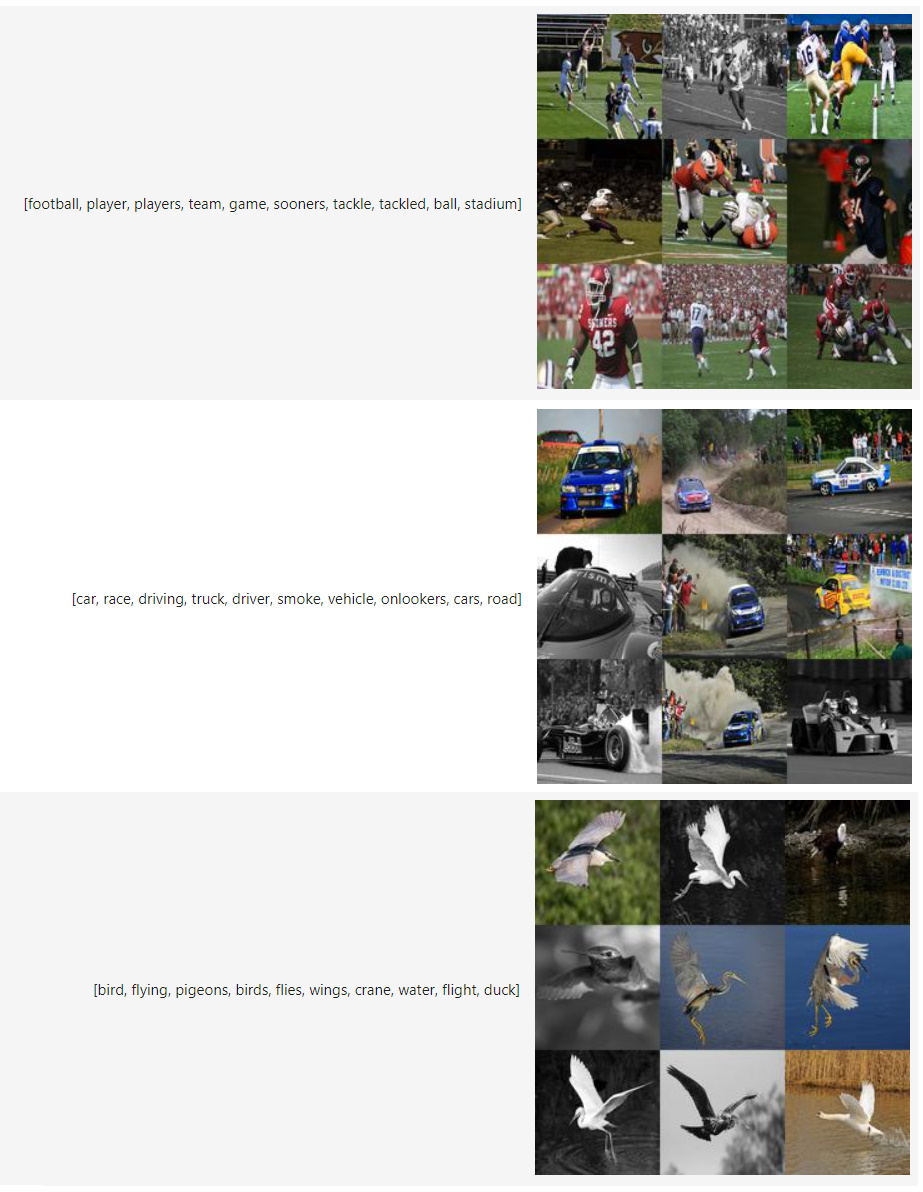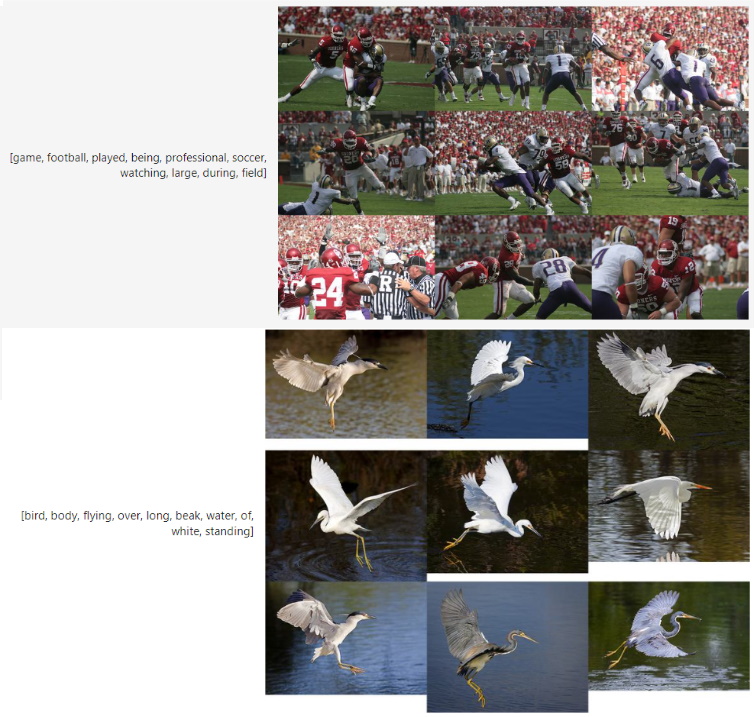Multimodal Topic Modeling
Documents or text are often accompanied by imagery or the other way around. For example, social media images with captions and products with descriptions. Topic modeling has traditionally focused on creating topics from textual representations. However, as more multimodal representations are created, the need for multimodal topics increases.
BERTopic can perform multimodal topic modeling in a number of ways during .fit and .fit_transform stages.
Text + Images¶
The most basic example of multimodal topic modeling in BERTopic is when you have images that accompany your documents. This means that it is expected that each document has an image and vice versa. Instagram pictures, for example, almost always have some descriptions to them.
In this example, we are going to use images from flickr that each have a caption associated to it:
# NOTE: This requires the `datasets` package which you can
# install with `pip install datasets`
from datasets import load_dataset
ds = load_dataset("maderix/flickr_bw_rgb")
images = ds["train"]["image"]
docs = ds["train"]["caption"]
The docs variable contains the captions for each image in images. We can now use these variables to run our multimodal example:
Tip
Do note that it is better to pass the paths of the images instead of the images themselves as there is no need to keep all images in memory. When passing the paths of the images, they are only opened temporarily when they are needed.
from bertopic import BERTopic
from bertopic.representation import VisualRepresentation
# Additional ways of representing a topic
visual_model = VisualRepresentation()
# Make sure to add the `visual_model` to a dictionary
representation_model = {
"Visual_Aspect": visual_model,
}
topic_model = BERTopic(representation_model=representation_model, verbose=True)
In this example, we are clustering the documents and are then looking for the best matching images to the resulting clusters.
We can now access our image representations for each topic with topic_model.topic_aspects_["Visual_Aspect"].
If you want an overview of the topic images together with their textual representations in jupyter, you can run the following:
import base64
from io import BytesIO
from IPython.display import HTML
def image_base64(im):
if isinstance(im, str):
im = get_thumbnail(im)
with BytesIO() as buffer:
im.save(buffer, 'jpeg')
return base64.b64encode(buffer.getvalue()).decode()
def image_formatter(im):
return f'<img src="data:image/jpeg;base64,{image_base64(im)}">'
# Extract dataframe
df = topic_model.get_topic_info().drop("Representative_Docs", 1).drop("Name", 1)
# Visualize the images
HTML(df.to_html(formatters={'Visual_Aspect': image_formatter}, escape=False))

Tip
In the example above, we are clustering the documents but since you have
images, you might want to cluster those or cluster an aggregation of both
images and documents. For that, you can use the new MultiModalBackend
to generate embeddings:
from bertopic.backend import MultiModalBackend
model = MultiModalBackend('clip-ViT-B-32', batch_size=32)
# Embed documents only
doc_embeddings = model.embed_documents(docs)
# Embedding images only
image_embeddings = model.embed_images(images)
# Embed both images and documents, then average them
doc_image_embeddings = model.embed(docs, images)
Images Only¶
Traditional topic modeling techniques can only be run on textual data, as is shown in the example above. However, there are plenty of cases where textual data is not available but images are. BERTopic allows topic modeling to be performed using only images as your input data.
To run BERTopic on images only, we first need to embed our images and then define a model that convert images to text. To do so, we are going to need some images. We will take the same images as the above but instead save them locally and pass the paths to the images instead. As mentioned before, this will make sure that we do not hold too many images in memory whilst only a small subset is needed:
import os
import glob
import zipfile
import numpy as np
import pandas as pd
from tqdm import tqdm
from sentence_transformers import util
# Flickr 8k images
img_folder = 'photos/'
caps_folder = 'captions/'
if not os.path.exists(img_folder) or len(os.listdir(img_folder)) == 0:
os.makedirs(img_folder, exist_ok=True)
if not os.path.exists('Flickr8k_Dataset.zip'): #Download dataset if does not exist
util.http_get('https://github.com/jbrownlee/Datasets/releases/download/Flickr8k/Flickr8k_Dataset.zip', 'Flickr8k_Dataset.zip')
util.http_get('https://github.com/jbrownlee/Datasets/releases/download/Flickr8k/Flickr8k_text.zip', 'Flickr8k_text.zip')
for folder, file in [(img_folder, 'Flickr8k_Dataset.zip'), (caps_folder, 'Flickr8k_text.zip')]:
with zipfile.ZipFile(file, 'r') as zf:
for member in tqdm(zf.infolist(), desc='Extracting'):
zf.extract(member, folder)
images = list(glob.glob('photos/Flicker8k_Dataset/*.jpg'))
Next, we can run our pipeline:
from bertopic.representation import KeyBERTInspired, VisualRepresentation
from bertopic.backend import MultiModalBackend
# Image embedding model
embedding_model = MultiModalBackend('clip-ViT-B-32', batch_size=32)
# Image to text representation model
representation_model = {
"Visual_Aspect": VisualRepresentation(image_to_text_model="nlpconnect/vit-gpt2-image-captioning")
}
Using these models, we can run our pipeline:
from bertopic import BERTopic
# Train our model with images only
topic_model = BERTopic(embedding_model=embedding_model, representation_model=representation_model, min_topic_size=30)
topics, probs = topic_model.fit_transform(documents=None, images=images)
We can now access our image representations for each topic with topic_model.topic_aspects_["Visual_Aspect"].
If you want an overview of the topic images together with their textual representations in jupyter, you can run the following:
import base64
from io import BytesIO
from IPython.display import HTML
def image_base64(im):
if isinstance(im, str):
im = get_thumbnail(im)
with BytesIO() as buffer:
im.save(buffer, 'jpeg')
return base64.b64encode(buffer.getvalue()).decode()
def image_formatter(im):
return f'<img src="data:image/jpeg;base64,{image_base64(im)}">'
# Extract dataframe
df = topic_model.get_topic_info().drop("Representative_Docs", 1).drop("Name", 1)
# Visualize the images
HTML(df.to_html(formatters={'Visual_Aspect': image_formatter}, escape=False))
